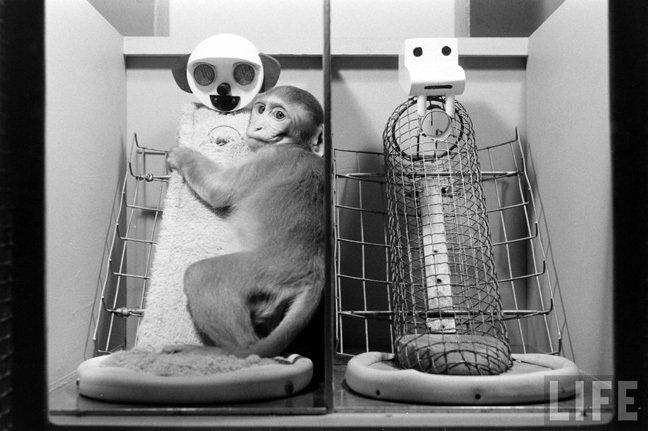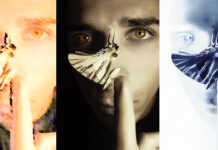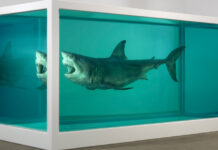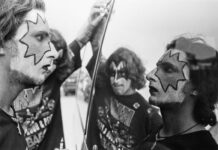The story you are about to read is absolutely true.
It is the story of the psychologist who tried to measure love. To achieve this, he tortured thousands of rhesus macaques in devices named Iron Maiden, Rape Rack and The Pit of Despair.
His colleagues called him the Nabokov of psychology. In the book of animal lovers, he was the de Sade of psychology.
He was looking for love, until the end of his days.
~{}~
Harry Israel was born in 1905 in a small town of the USA. His father was a failed inventor. Maybe he inherited the talent for constructing torture devices from him.
His mother was a depressive woman, cold and distant who never paid him any attention, despite all his efforts to do so. She was reduced to gaze Iowa’s flat land out of the window, disappointed.
In school, Harry was a “weird little misfit”. He was interested only in drawing and poetry, although in a place of Earth where the teacher would give poetry assignments with the subject “the beauty of brushing your teeth”.
He was constantly drawing on his notebook the weird creatures of an imaginary land called Yazoo. When he was done with the picture, he would bisect the animals with the red pencil.
~~
In high school Harry was an average student and not so popular. He was speaking with a lisp, he was limping and he was dressing like an old man. No one was paying attention to him and he was not on speaking terms with confidence. But he would work hard and was determined with out-of-this-world faculties when committed.
Therefore, when he would embark on an assignment, he would stay awake round the clock doing nothing else until he was done with it.
~~
He pulled off to enter the Stanford University where he was supervised by Lewis Terman, famous for his work about the IQ tests. There, among children and youths with IQ higher than Eistein’s, the dull Harry was even more out of place.
Terman told him he had no future in psychology. Harry set to work with his dedication increased by a factor of ten. He was not as smart as his classmates, but none of them was half determined as he was.
Impressed by his commitment, Terman told him to change his name and perhaps he could achieve something in a smaller university.
~~
Harry Israel became Harry Harlow. By this name is to be encountered in every book of psychology.
The man who was supposed to have no future whatsoever in psychology, would serve as head of the American Psychological Association and would be awarded with the National Medal of Science. But it came at a price since he had to torture thousands of primates.
Is love tied with pain?
~~~{}~~~
Harlow got married to a gifted classmate who had an IQ above 155.
They met each other at the Madison University where he was experimenting with rats, but not before long he switched to macaques. He experimented with their ability to solve problems.
He was doing pretty well, so the University allowed him to use an old box manufacturing building as a laboratory to make further progress with his experiments. This place would become a hell for the animals.
~~
Harlow separated the infants from their mothers in order to study their intelligence.
Then, he noticed something strange: When the infants were left on their own they would cling to the cheesecloth pad at the bottom of the cage.
They were cuddling it while sleeping, they would never let it go and they were distressed if someone was trying to take it away from them. They were indifferent about the food they were given; only the cloth would calm them down.
~~{}~~
Until then, namely the 1950s, the attachment to the mother had been attributed to food supply. The baby is attached to its mother, because it instinctively knows that her breasts will provide food. It needs its mother because she feeds it.
Until Harlow arrived on the scene, the love towards mother as well as human attachment were confined to drive reduction theory. We love because we are hungry!
Harlow proved that it is not food that the baby seeks from its mother. He proved that love is much more than breast milk.
~~{}~~
That is how Harlow’s first large-scale experiment started.
He made two “mothers”.
The first one was made from wire with a steel breast and a steel nipple where milk came out from. This was the “biological mother”.
The second one was made from paper wrapped in a soft cloth. This was the “step mother” and had no breast.
In the initial experiment, both mothers were faceless.
~~
The inauguration of the experiment involved a lot of pain. Tens of new-born babies were taken forcibly from their mothers and they were put to the cage with the two surrogate ones.
Students that participated in the experiment described the pain the animals felt. The mothers would scream and bang their heads against the cage. The babies would fill the place with excrements and then they would curl up in the corners like tiny fluffy balls.
Harlow would make observations, being even colder than his own mother.
He said once: “The only thing I care about is whether a monkey will turn out a property I can publish. I don’t have any love for them. I never have. I don’t really like animals. I despise cats. I hate dogs. How could you love monkeys?”
~~
A few days later, he observed something unheard-of for the fundamentals of the then psychology. The babies showed more affection to the cloth mother, since the biological one was absent.
They spent all day and night in her lap, frightened. They would go to the biological mother only to drink some milk and then they would hurriedly return to the warm embrace of the cloth mother.
Harlow made a graph depicting the time the infants spent with the “biological mother” compared to the time they spent in the lap of the soft “stepmother”.
The results were phenomenal and Harlow’s conclusion unprecedented.
“The primary function of nursing as an affectional variable is that of insuring frequent and intimate body contact of the infant with the mother”.
It is not the food, the milk that the baby seeks from her, but the warmth of the embrace, the contact!
~~{}~~
Harry Israel, deprived of maternal love, achieved to prove that the touch, affection, love was more important than food. All you need is love.
He went even further than that. Subsequent experiments revealed that every emotional interaction throughout our life is, to a great extent, a repetition and a new version of the first touch.
~~
The experiments of Harlow, who soon became a known scientist, influenced all the fields that have to do with infants.
The practice of skin-to-skin care, namely to place the new-born baby immediately on the mother’s chest, began thanks to Harlow’s experiments.
The sling, which brings the baby in immediate contact with its mother’s body, is a by-product of Harlow’s experiments.
~~
Later, Harlow proved that the mother’s hug, the maternal acceptance, may define a man’s entire life.
~~
Second part The stabbing mother – Harlow’s experiments
~~~~~~~~~~~~~~~~~~









